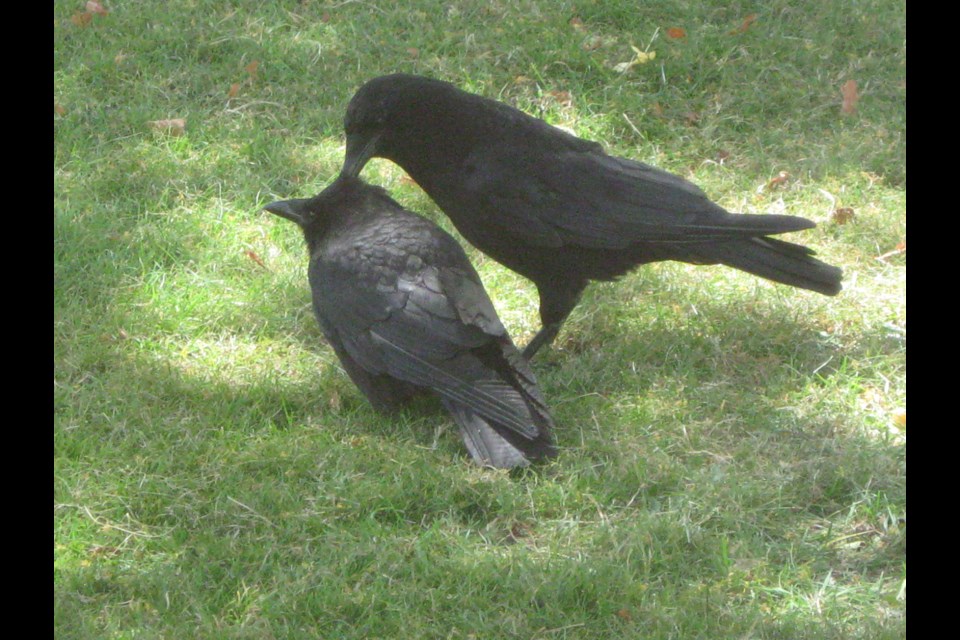There was a man in Florence who was very genial but who annoyed me to no end. Everything about him – especially his cocky attitude – riled me, to the point that I was often rather rude to him. My behaviour had no effect. He continued to be cheerful. Eventually, won over by his imperviousness, I accepted him for what he was and we became friends.
I tell this story because I’ve had a similar experience with crows. Their habits ruffled my feathers. On garbage collection day they’d deposit lobster claws, bones and bread chunks in my garden and gutters. Crows belong to the family known as Corvidae (from the Latin for raven, “corvus”), and like some other species in that family, they raid the nests of smaller birds. One day I found pieces of two newly-hatched birds in the yard. My anti-crow sentiment hit new heights.
But gradually my anger waned. Accepting that no decree from a higher authority, or my own despair, would ever change the nature of crows, I went to the supermarket and bought peanuts.
The change in my attitude coincided with the year my street got a new “grounds manager.” I dubbed her Mrs. Crow. She was as brash as that man in Florence, and I couldn’t help myself – I was amused. At the beginning she used a lot of charm to get my attention. She’d meow like a cat, simultaneously making a kind of sinuous body movement. She’d also bark, not “woof, woof,” more “arf, arf.” As soon as I appeared in the morning, she’d swoop on top of my car and amble across the roof – meaning “bring out the peanuts!”
One day last spring she came with a tiny crow. It was her baby. When Mrs. Crow proceeded to feed it in my presence I felt extraordinarily privileged. I immediately increased her daily peanut ration.
After that, the two always came together, and I witnessed the youngster learning crow skills and watched the parent-child relationship develop. During last year’s hot summer, they spent a lot of time near the big saucers of water on the lawn to quench their thirst and cool off.
Mrs. Crow’s routine made me think of a Victorian lady in a voluminous bathing costume taking a dip. She stepped into the saucer, lifting her wings as if raising the skirt of her costume, and then lowered herself, wiggling energetically. Occasionally, growing impatient while waiting for its turn, the young crow made a rattle call, a sound like a guttural stutter. All in her own time, Mrs. Crow rose and gave a mighty shake to expel the water from her feathers. As she stepped out of the saucer, the youngster hopped in. Not yet having mastered the elegant movements of its mother, it plopped around and splashed, emptying the saucer of all its water.
One day in July the two crows did something that held me spellbound – the young one began preening its mother’s head, searching with its beak for dirt and parasites under the short feathers and then carefully smoothing them down. Allopreening (one bird preening another of the same species) is a ritual often associated with courtship, which couldn’t have been the case here. Instead, it must have been an act of parent-child bonding.
The pecking order among crows seems unbreakable, although I’ve detected hints of a rebellious streak in the youngster. If it happens to arrive before Mrs. Crow, it doesn’t dare fly on to my car roof, but stays on the ground. However, when Mrs. Crow darts like a bullet to nab all the peanuts I toss to both of them, her offspring eventually gets fed up and lets loose an unusually fierce rattle call.
Young crows stay with their parents for years, and I hope Mrs. Crow knows that she and her brood are always welcome here. After all, I’m paying peanuts for a show that’s more entertaining than anything Netflix could ever offer.
Sabine Eiche is a writer and art historian (www.sabinedellarovere.com)



